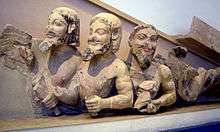Hekatompedon temple
Coordinates: 37°58′17″N 23°43′36″E / 37.9715°N 23.7267°E
| Hekatompedon | |
|---|---|
 Sculpture from the east pediment depicting a lion killing a calf | |
| General information | |
| Type | Temple |
| Architectural style | Ancient Greek Archaic |
| Location | Athens, Greece |
| Current tenants | Museum |
| Construction started | ca. 570 BC |
| Completed | ca. 550 BC |
| Destroyed | 490 BC (Persian Wars) |
| Owner | Greek government |
| Design and construction | |
| Architect | unknown |
The Hekatompedon or Hekatompedos (Ancient Greek: ἑκατόμπεδος, from ἑκατόν, "hundred", and πούς, "foot"), also known as Ur-Parthenon and H–Architecture, was an ancient Greek temple on the Acropolis of Athens built from limestone in the Archaic period, and was placed in the position of the present Parthenon.
Etymology
The name of the temple was found in inscriptions and means “100 feet long” (ca. 30 m), although its length reached 46 m.
History
The temple was built around 570–550 BC. It was demolished by the Athenians in 490 BC after the victory over the Persians at Marathon to build a larger temple known as the Older Parthenon. The latter was destroyed in 480 BC by the returning Persians and finally replaced by the present Parthenon. The existence of the Hekatompedon is witnessed by historical documents. Its foundations have disappeared, but architectural and sculptural elements found in the southern part of the Mycenaean wall of Acropolis have been assigned by scholars to this temple.
Description
The surviving architectural elements indicate that the length of its crepidoma was probably ca. 46 m, that the temple was peripteral and of doric order.

One of the pediments (perhaps the West pediment) contained two lions tearing apart a bull in the centre, Herakles defeating Triton (the sea monster half-human and half-snake) on the left and the "three-bodied daemon" on the right. The three elements are conserved in the Acropolis Museum of Athens and had been, until recently, misassigned to the close Temple of Athena Polias. The three bodies of the winged monster hold a wave, a flame and a bird and have intertwined snake tails, symbolizing the four natural elements, i.e. water, fire, air and earth, respectively. It represents either Nereus or Typhon. Overall the meaning of the whole pediment is mysterious. Some scholars believe that it means the dominance of the human wisdom over humidity: the lions are earth animals, whereas the bull represent humidity. In addition, both Triton and Nereus were sea creatures defeated by Herakles on its way to the Hesperides garden, which earned him immortality.

The East pediment, also known as the Lioness pediment, contained in the centre two symmetrically placed lions killing a calf (only one has been recovered) and two snakes on the side corners. The meaning of this scene is again unknown. The lioness has both female (breast) and male (mane) details, probably arising from the lack of knowledge of the Greek artists on these animals, which no longer populated Greece in the 6th century BC.

Other surviving sculptures include four horses and two panthers carved in relief, both from metopes of the temple, and a very fragmentary gorgon from the central acroteryon.
In the main temple was placed the wooden statue (from olive wood) of Athena Polias, and in the megaron (or opisthodomos) votives, the treasures, and material of the worship.
Style

The style of the sculptures is typical of the early Archaic period. The overall narrative scenes of the pediments and metopes is half narrative, including human or semi-human figures, half animal, including animals placed in a symmetrical or repetitive fashion. This reminds of the illustrations of contemporary Greek pottery. Humans were characterized by the archaic smile. The human and animal bodies are carved with lack of confidence, compared to the sculptures of the temple of Athena Polias constructed in the Acropolis, half a century later.
See also
References
- Stamatia Eleftheratou, Acropolis Museum, guide, Acropolis Museum Editions, Athens 2014
- The Hekatompedon at the website of the Acropolis Museum ; Retrieved 19 November 2014